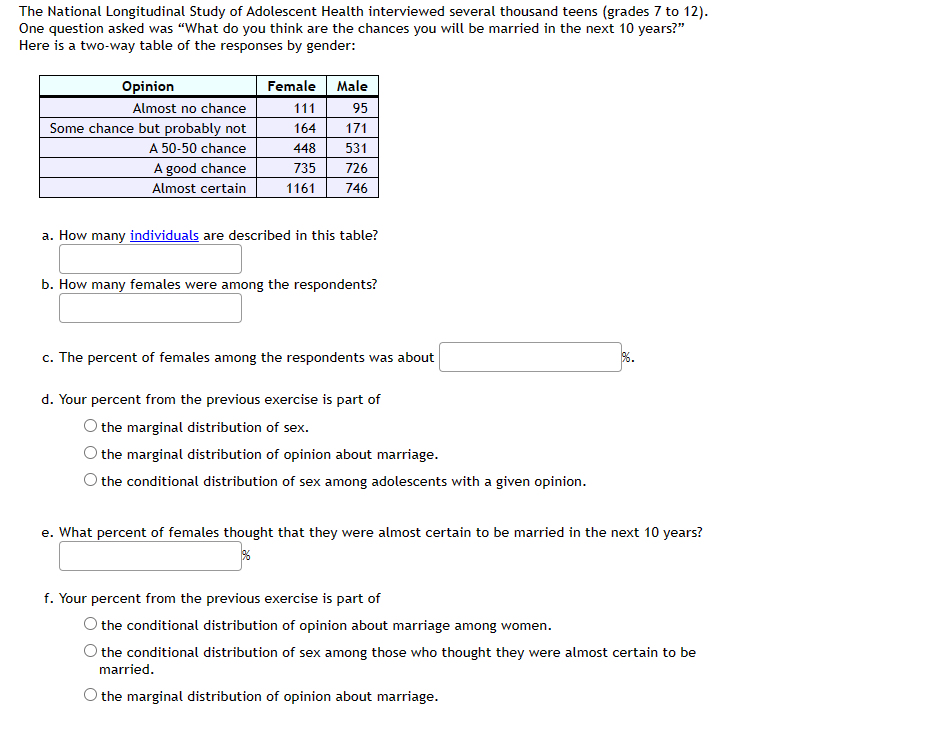The National Longitudinal Study of Adolescent Health interviewed several thousand teens (grades 7 to 12). One question asked was "What do you think are the chances you will be married in the next 10 years?" Here is a two-way table of the responses by gender: Opinion Almost no chance Some chance but probably not A 50-50 chance A good chance Almost certain Female 111 164 448 735 1161 Male 95 171 531 726 746 a. How many individuals are described in this table? b. How many females were among the respondents? c. The percent of females among the respondents was about d. Your percent from the previous exercise is part of the marginal distribution of sex. the marginal distribution of opinion about marriage. the conditional distribution of sex among adolescents with a given opinion. de e. What percent of females thought that they were almost certain to be married in the next 10 years? f. Your percent from the previous exercise is part of the conditional distribution of opinion about marriage among women. O the conditional distribution of sex among those who thought they were almost certain to be married. O the marginal distribution of opinion about marriage.
The National Longitudinal Study of Adolescent Health interviewed several thousand teens (grades 7 to 12). One question asked was "What do you think are the chances you will be married in the next 10 years?" Here is a two-way table of the responses by gender: Opinion Almost no chance Some chance but probably not A 50-50 chance A good chance Almost certain Female 111 164 448 735 1161 Male 95 171 531 726 746 a. How many individuals are described in this table? b. How many females were among the respondents? c. The percent of females among the respondents was about d. Your percent from the previous exercise is part of the marginal distribution of sex. the marginal distribution of opinion about marriage. the conditional distribution of sex among adolescents with a given opinion. de e. What percent of females thought that they were almost certain to be married in the next 10 years? f. Your percent from the previous exercise is part of the conditional distribution of opinion about marriage among women. O the conditional distribution of sex among those who thought they were almost certain to be married. O the marginal distribution of opinion about marriage.
Chapter8: Sequences, Series,and Probability
Section8.7: Probability
Problem 11ECP: A manufacturer has determined that a machine averages one faulty unit for every 500 it produces....
Related questions
Question
For this homework question how do I find part a, part b, part c and part e?

Transcribed Image Text:The National Longitudinal Study of Adolescent Health interviewed several thousand teens (grades 7 to 12).
One question asked was "What do you think are the chances you will be married in the next 10 years?"
Here is a two-way table of the responses by gender:
Opinion
Almost no chance
Some chance but probably not
A 50-50 chance
A good chance
Almost certain
Female
Male
111
95
164
171
448
531
735
726
1161 746
a. How many individuals are described in this table?
b. How many females were among the respondents?
c. The percent of females among the respondents was about
d. Your percent from the previous exercise is part of
the marginal distribution of sex.
the marginal distribution of opinion about marriage.
the conditional distribution of sex among adolescents with a given opinion.
e. What percent of females thought that they were almost certain to be married in the next 10 years?
%
f. Your percent from the previous exercise is part of
the conditional distribution of opinion about marriage among women.
the conditional distribution of sex among those who thought they were almost certain to be
married.
the marginal distribution of opinion about marriage.
Expert Solution
This question has been solved!
Explore an expertly crafted, step-by-step solution for a thorough understanding of key concepts.
This is a popular solution!
Trending now
This is a popular solution!
Step by step
Solved in 3 steps with 2 images

Recommended textbooks for you

